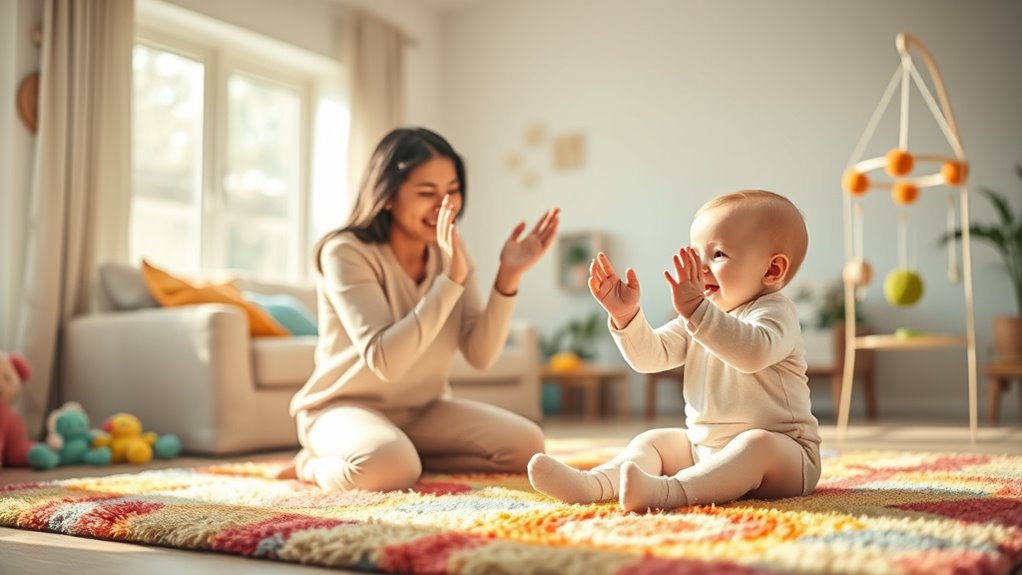To teach your baby to clap, start by modeling the action yourself. Incorporate music during daily routines to grab their attention. Use playful songs like “If You’re Happy and You Know It” and engage them with clapping games. Show excitement with verbal cues like “Yay!” and respond with enthusiasm when they attempt to clap. Encourage social interaction through these fun activities. Keep it lively, and you might discover even more ways to spark their interest in clapping!
Key Takeaways
- Start clapping yourself during playtime to model the action for your baby to imitate.
- Incorporate music and rhythmic songs to make clapping fun and engaging.
- Use interactive games like “If You’re Happy and You Know It” to encourage clapping participation.
- Provide positive reinforcement by celebrating your baby’s attempts to clap with enthusiasm and praise.
- Engage in consistent clapping activities to reinforce the behavior and foster bonding moments.

Teaching your baby to clap can be a delightful experience that enhances their motor skills and communication. Babies typically start clapping between 9 to 12 months old, and this milestone not only showcases their developing motor skills but also opens the door to communication. Initially, your little one will clap to imitate you or others around them. As they grow more comfortable with the motion, clapping will evolve into a joyful expression, helping them communicate excitement or happiness.
To encourage this skill, incorporate music into your daily routine. Playful rhythms can grab your baby’s attention, so set up clapping games to the beat of their favorite tunes. Nursery rhymes like “Pat-a-Cake” are perfect for teaching clapping motions. Encourage your baby to participate in songs that involve clapping, varying the speed and tempo to keep things engaging. The auditory stimulation from music not only enhances their development but also motivates them to move along with the sounds.
Modeling gestures is vital. When you clap, do it consistently and in various contexts, so your baby understands that clapping is a fun and engaging activity. Use verbal cues like “Yay!” when clapping, making it even more exciting for them. Repetition is key; the more often you demonstrate clapping, the more likely they’ll want to join in. Make it interactive by clapping together, turning the activity into a bonding moment.
Incorporate games and activities that involve clapping. Play “If You’re Happy and You Know It” or give high fives to encourage hand movement. Use “Pat-a-Cake” to introduce clapping and pointing. Games like peekaboo can also include gestures, making the activities more dynamic. This social interaction is crucial for your baby’s development, as it reinforces their understanding of gestures.
Respond to your baby’s clapping with enthusiasm. Acknowledge their gestures and mimic them to encourage more. Provide positive feedback every time they clap, reinforcing the behavior. Consistent engagement in activities that promote gestural communication will help your baby feel empowered and understood.
Clapping is a stepping stone in developing fine motor skills and hand-eye coordination, laying the groundwork for future movements. It also serves as an early form of nonverbal communication, helping express emotions and fostering social interaction.
As your baby learns to clap, they’re not just mastering a fun skill; they’re building the foundation for future speech and vocabulary expansion. So, enjoy this precious time and celebrate their progress!
Frequently Asked Questions
At What Age Can Babies Typically Start Clapping?
Babies typically start clapping between 8 to 12 months old.
At around 9 months, they can bang objects together, which shows they’re developing fine motor skills.
Clapping is more than just fun; it’s a key milestone that indicates growth in coordination and social interaction.
What if My Baby Doesn’t Clap at All?
So, your baby isn’t clapping yet—what a tragedy! Just kidding!
It’s perfectly normal for babies to develop at their own pace. If your little one hasn’t started clapping, don’t stress. Focus on their overall development; they might shine in other skills.
Keep engaging with them through fun activities and social interactions. If you’re still worried after 18 months, a quick chat with your pediatrician can provide peace of mind.
Patience is key!
Are There Benefits to Teaching Clapping Early?
Yes, teaching clapping early has numerous benefits for your baby.
It promotes social development, helping them connect with others, and boosts language skills by encouraging expressive gestures.
Clapping enhances their motor skills and coordination, while also allowing them to express emotions like joy and excitement.
Additionally, it fosters imitation skills as they learn from you, laying a strong foundation for communication and interaction in their future development.
Can Clapping Help With My Baby’s Motor Skills?
Yes, clapping can significantly help your baby’s motor skills. It promotes coordination and muscle strength as they engage both hands in a synchronized motion.
This activity enhances fine motor control and improves hand-eye coordination, essential for other skills like waving and pointing. By practicing clapping, your baby develops overall gross and fine motor skills, making it a fun and beneficial milestone in their physical development.
Encourage this activity to support their growth!
Should I Use Music to Encourage Clapping?
Absolutely, you should use music to encourage clapping! Music boosts your baby’s rhythmic awareness and motor skills while making the experience enjoyable.
When you play interactive songs, your little one can easily mimic your actions. Plus, music helps regulate emotions, keeping them focused and engaged.
Incorporating clapping games into your daily music sessions fosters social interaction and strengthens your bond, making clapping a fun and rewarding activity for both of you.
Conclusion
So there you have it—teaching your baby to clap is practically a walk in the park, right? Just remember, if they don’t master it immediately, it’s not a sign of future career failure. They might just be plotting their own round of applause for your parenting skills instead! Who wouldn’t want an enthusiastic toddler giving you a standing ovation? So keep those hands busy and prepare for some seriously cute moments ahead, even if they’re a bit delayed!









